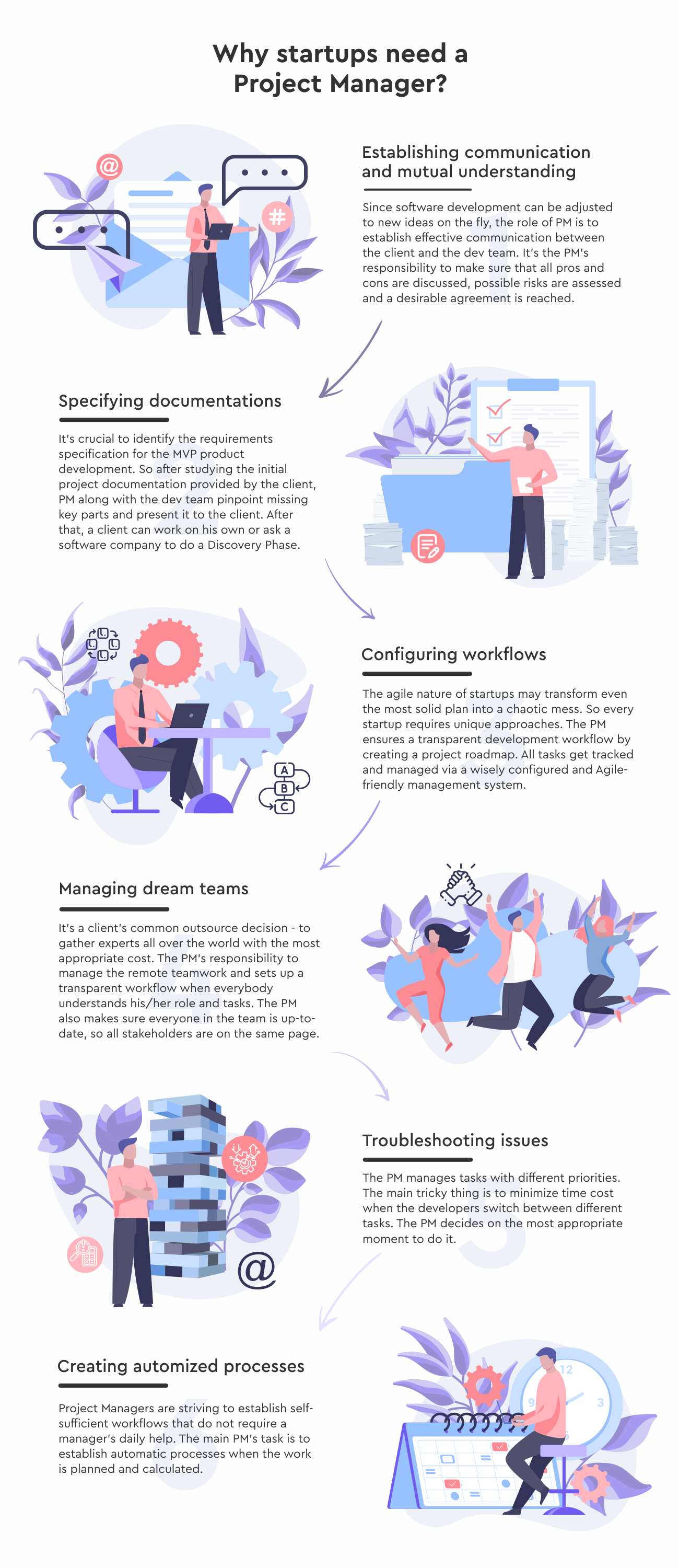Startups are not an easy thing to plan and implement. You may come up with an incredible idea of how to solve a problem but have no clue about its practical implementation. You may find a successful business model, and yet a visual aspect of it may be blurred. Or you may gather a lot of possibly-working pieces in your head and be puzzled over what would actually fly.
All it comes to one thing - there are missing parts in your insight, and it’s absolutely OK! You cannot be a true professional in all fields and aspects of life. That’s why the design, development, and business analyst teams exist to help you. However, who would identify these gaps in a from-the-first-glance-perfect-idea? Who would help you to decide what parts are ready and what should be further worked out? Who would help you to find the best approaches for creating your application that would fly?
As a software development company, we have provided high-quality outsourcing services for over 7-years. Based on our experience, it’s really a rare case when the client has a complete vision of the app and its development flow. The task gets more complicated due to the startup nature. Startup projects tend to constantly change and evolve to fit the customer's needs.
This is why projects need IT Project Managers (PM) - guys, who track all the missing parts and solve any occurring issues ASAP. PMs ensure a stable workflow even in the most emergency cases with minimum damage to the budget. So, let’s discuss the step-by-step evolution of the startup project and find out what does a project manager do on each stage.

Step 1: Establishing communication and mutual understanding
Due to the agile nature of the startups, such projects are ever-changing. New ideas arise, and some of them may be critical for the in-progress development in terms of the implementation.
The digital development is pretty similar to the architecture craft. You write certain schematics, build some foundations, create and adjust all the parts together. You can hardly transform a half-built church into regular living quarters. This is pretty similar in the development. Once something was created in a certain way and for certain needs, you cannot be sure it could be transformed for different purposes.
So, very often the business requires to add a new feature or change the existing one. It may seem a minor change to the client but it’s not always true in terms of the development. This is where issues begin to occur. At this stage, the role of PM is to establish effective, frequent, and transparent communication between all of the project stakeholders. In the above-mentioned case, an agreement with the minimum cost for the client can be reached only via a clear discussion. It’s the PM’s responsibility to make sure that all pros and cons are discussed, possible risks are assessed and a desirable agreement is reached between the client and the dev team. It’s also up to PM to translate the ‘technical language’ for the client and elaborate on the ‘business language’ for the developers. In other words, the PM should make sure everybody understands things in the same way.
Another case is when the project documentation lacks details but the client needs to launch the development ASAP. It’s absolutely possible to add documentation missing details and develop at the same time with the professional PM. In this case, the PM wisely separates the workflow into communication and development hours. Moreover, the experienced PM saves time since he/she figures out some missing details with the client on his/her own, while the team works on the already clarified parts. This is especially helpful when the team and the client live in different timezones.
Finally, the client can always check the current progress in the specific status tools configured by the PM or simply schedule a call with the PM to quickly dive into details if needed.
To summarize the 1st Step:
Startups have ever-changing nature;
Though pretty similar to construction, software development still can be adjusted to new ideas on the fly. The PM makes sure the adjustments are optimized as much as possible;
The first thing for the PM to do is to establish a constant transparent communication between the Product Owner and the Development team. Regardless of possible challenging conditions such as early development start or timezone differences, the PM should find the most appropriate way for the stakeholders to communicate.
Step 2: Specifying documentation
It’s of the utmost importance for every startup to identify its minimum viable product (MVP) features. Pretty often the client cannot provide clearly stated product features due to the lack of expertise. The PM along with the developer are the ones, who pinpoint missing key parts and present it to the client. Then it’s up to the client to decide whether he would work on adding the missing details on his/her own or ask us to do a Discovery Phase.
In the latter case, 2muchcoffee provides a team, which consists of a PM, Business Analyst, UI/UX designer, Senior Developer. The role of the team is to ensure effective business logic, high-quality design, and robust development.
The Business Analyst puts under scrutiny the market and main competitors to come up with the recommendations for the startup development strategy. The UI/UX Designer works on the best ideas to ensure a user-friendly experience. The Senior Developer provides suggestions about the tech stack of the app. He is responsible for clear source code which will be resulted in a flexible and scalable app.The PM role is to be a connecting-link in the so-called chain of development. As an official representative of the client-side in the Discovery Phase, the PM makes sure the client’s suggestions and ideas are taken into consideration.
Discovery Phase team’s suggestions then get communicated by the PM to the client for making a final decision. If there are any changes to the existing verified documentation, the PM lets the client know about the impact of these changes on the overall time and scope of the project.
Brief of the 2nd Step:
Initial documentation is provided by the client. The PM’s responsibility is to establish a requirements specification work;
After the missing parts are identified, the client can either work them out or ask 2MC for a Discovery Phase;
Discovery Phase is a process of working on the project documentation with the help of a Business Analyst, Designer, Senior Developer and PM. The PM is the client’s representative in the Discovery Phase.
Step 3: Configuring workflow
After the documentation is agreed upon and accepted by all stakeholders, it's a great time for the PM to come up with decisions regarding an appropriate workflow.
The young startup teams usually make one common mistake. They all stick to the rigid theory of Agile Methodologies and shape the workflow according to it. In fact, like in any other field (and IT Project Management is not an exception), the theory is just information about existing approaches and tools. Would you use a claw hammer, ax, saw, paintbrush, shovel, and chisel altogether to craft a door? You would pick up only the tools you really need.
The same is about the development workflow. If something irrelevant is added to the workflow, it makes the process slower, harder for the understanding, and less effective as a result. It’s critical to understand that each project is a wholly unique venture that requires a unique approach.
The most important things, that the PM should consider before starting the development, are:
task management tool;
time management tool;
methodology.
Would it be a well-optimized Clubhouse project with a Kanban approach and without a time/activity tracker? Or it would be more appropriate to create a classic greatly-customizable project in Jira with a Scrum approach and Hubstaff tracker? The answer is - it depends, and the PM is the one to make a correct and more suitable decision for the client.
When the initial workflow is established, there are two things that the PM should constantly maintain with the team’s help.
1) High-quality task descriptions. From the very beginning, the PM should establish an effective task template. It should include a clear description with specified acceptance criteria and definition of done. Additionally, without it, it would be impossible for the QA to ensure quality by testing the functionality. Also, it creates a ‘version2’ of the project documentation as, very often, there is a lot of communication going in the task comments section. Some important and crucial decisions may be made, and, after the discussion is done, the task description should be updated with the discussion results.
2) Blockers management. For agile software development, it’s quite natural to have some blocked development tasks due to the absence of the designs or final decisions. It’s quite important for the PM to create a system of labels and filters to easily track and memorize the ‘to-does’. If the blocker is dependent on the team, the PM should guide the team’s efforts in order to resolve the blockers. The main point about it is to always minimize the work in progress and reach a logical ending for each task before starting a new one.
A quick run-through of the 3rd step:
Every startup is a unique venture that requires unique approaches;
The PM decides what time and task tracker systems would be the most appropriate for the project along with the methodology to follow;
The PM ensures a transparent development workflow by creating a project roadmap. All tasks get tracked and managed via a wisely configured and Agile-friendly management system.
Step 4: Managing a dream team
It’s a client’s common outsource decision - to gather the best professionals from all around the world and create a dream team with the most appropriate cost. However, managing people from different timezones is not an easy task for the client, who, very often, has other businesses to do, besides the startup.
Again, it’s also the PM’s responsibility to manage the remote team work to facilitate the project’s progress. The easiest and the most right way to do this is to set up a transparent workflow when everybody understands his/her role and tasks. The PM also makes sure everyone in the team is up-to-date, so all stakeholders are on the same page.
PM's job includes taking care of a state of each member in a team. How come? When the deadlines are tight and the tasks are reaching the highest Fibonacci numbers, people start pushing themselves too hard. This may result in burnout, which is unacceptable for professional management. It’s up to the PM to come up with an idea of how to reduce the stress without any damage to the quality.
The 4th step in a nutshell:
Sometimes the client assembles a few remote teams to work on the same startup. The PM configures the flow in a way it is transparent for everybody. With PM’s help, 2MC members understand their roles and tasks as clear as other remote teams do on such a project.
PM takes care of people on the project, not letting them burn out regardless of working pressure.
Step 5: Troubleshooting issues
Troubleshooting is needed both on the live product maintaining and during the MVP development. From time to time it’s needed to prioritize the critical bug fixing or key features development over the in-progress work. With the PM on the project, the client can just inform a team about the urgent task to do. The PM then takes care of assigning the task to the appropriate team member. The Project Manager also assesses risks connected to the workflow violation and let the client know about the possible consequences.
A recapped vision of the 5th Step:
The PM manages tasks with different priorities. The main tricky thing is to minimize time cost when the developers switch between different tasks. The PM decides on the most appropriate moment to do it.
Step 6: Creating the automized process
2MC Project Managers are striving to establish self-sufficient workflows that do not require a manager’s daily help. A key point to evaluate the quality of the PM’s work is to take a look at how many hours per day the PM spends on a certain project. The less the amount of hours, the more professionally the project was configured.
Especially great opportunity to assess the project’s transparency is to examine it when its PM is on vacation. If the process continues flying, then you hired the right person.
Step 6 - short and sweet:
A good PM does not babysit the project. The main PM’s task is to establish automatic processes when the work is planned and calculated.

Conclusion
Instead of repeating all the material above, we want to stress that the agile nature of startups may transform even the most solid plan into a chaotic mess. Therefore, the role of the Project Manager is to ensure the most stable workflow even in most emergency cases with minimum damage to the budget.
Looking for a Project Manager for your startup? Or do you have some questions about the software product development? Do not hesitate to contact our team and we will assist you in any inquiry.





